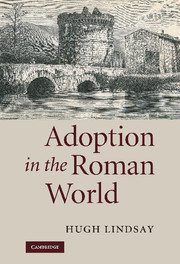Book contents
- Frontmatter
- Contents
- List of figures
- Preface
- List of abbreviations
- Introduction
- 1 Adoption, kinship and the family: cross-cultural perspectives
- 2 Kinship in Greece and Rome
- 3 Greek adoptions: comparisons and possible influences on the Roman world
- 4 Procedural aspects of Roman adoption
- 5 The testamentary adoption
- 6 Roman nomenclature after adoption
- 7 Adoption and inheritance
- 8 Roman freedmen and their families: the use of adoption
- 9 Adoption in Plautus and Terence
- 10 Sallust and the adoption of Jugurtha
- 11 Adrogatio and adoptio from Republic to Empire
- 12 Testamentary adoptions – a review of some known cases
- 13 Political adoptions in the Republic
- 14 Clodius and his adoption
- 15 The adoption of Octavian
- 16 Political adoption in the early Empire at Rome, Pompeii and Ostia; the imperial family
- Conclusion
- Glossary
- References
- Index
4 - Procedural aspects of Roman adoption
Published online by Cambridge University Press: 25 January 2010
- Frontmatter
- Contents
- List of figures
- Preface
- List of abbreviations
- Introduction
- 1 Adoption, kinship and the family: cross-cultural perspectives
- 2 Kinship in Greece and Rome
- 3 Greek adoptions: comparisons and possible influences on the Roman world
- 4 Procedural aspects of Roman adoption
- 5 The testamentary adoption
- 6 Roman nomenclature after adoption
- 7 Adoption and inheritance
- 8 Roman freedmen and their families: the use of adoption
- 9 Adoption in Plautus and Terence
- 10 Sallust and the adoption of Jugurtha
- 11 Adrogatio and adoptio from Republic to Empire
- 12 Testamentary adoptions – a review of some known cases
- 13 Political adoptions in the Republic
- 14 Clodius and his adoption
- 15 The adoption of Octavian
- 16 Political adoption in the early Empire at Rome, Pompeii and Ostia; the imperial family
- Conclusion
- Glossary
- References
- Index
Summary
background and historical development of adoption at rome
Adoption can be defined as a method developed to regulate the entry of new members to the family. This chapter is concerned with the procedures and formalities used to complete an adoption at Rome, and attempts, in so far as is possible, to assess how and when they originated, and how they developed over time. A previous chapter (2) discussed older views of Roman kinship, which were dominated by an evolutionary approach. Roman adoption as an institution has also been seen in evolutionary terms. The resulting picture is now embedded in modern thinking about Roman adoption. It is thus hard to study adoption without a coherent approach to the Roman family and its development, whether evolutionary or otherwise. Political arrangements also go hand in hand with any discussion.
For the earliest phases of Roman history, little can be said about family structures since there are no contemporary sources, and there is little prospect of using later sources to create a completely convincing picture. In the late Republic and early Empire a text from the Twelve Tables was considered important in understanding issues of personal status within the family. Table iv: 2 is a text relating to emancipation, and its significance has been much discussed:
si pater filium ter venum duit, filius a patre liber esto.
(Crawford [1996] ii: 631–2)- Type
- Chapter
- Information
- Adoption in the Roman World , pp. 62 - 78Publisher: Cambridge University PressPrint publication year: 2009



